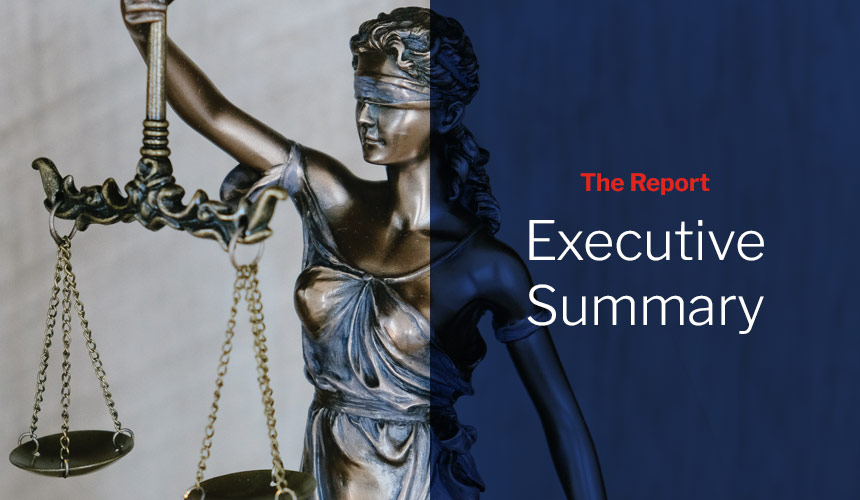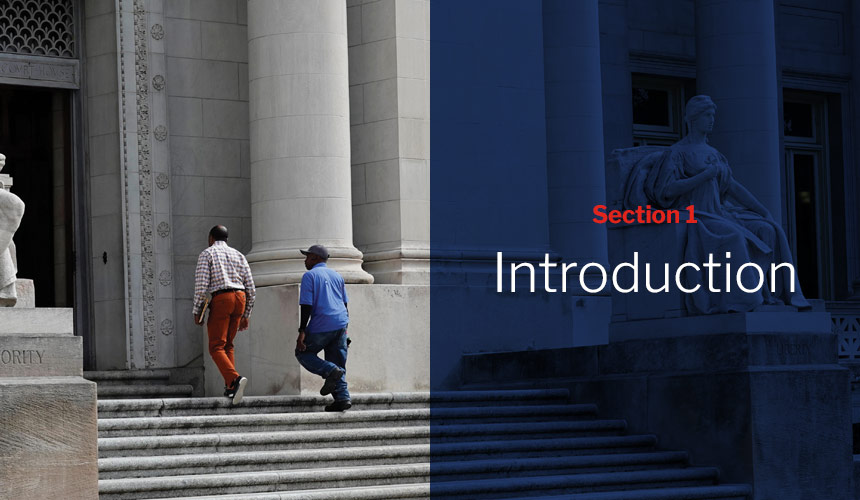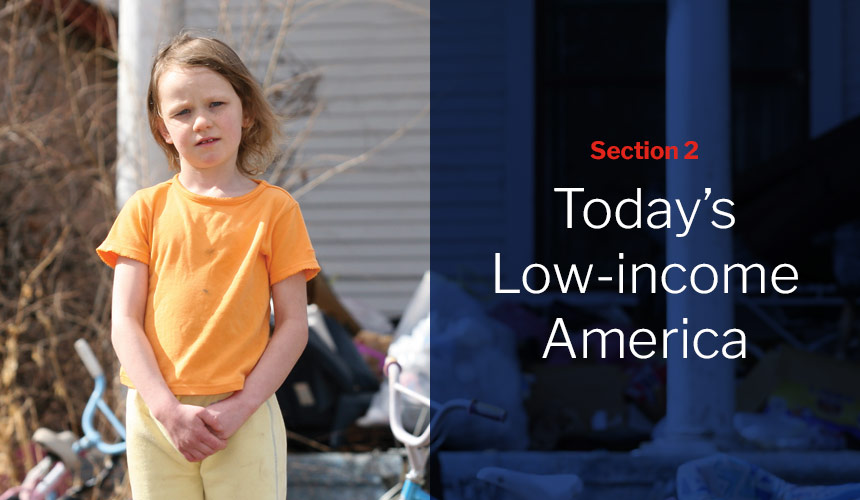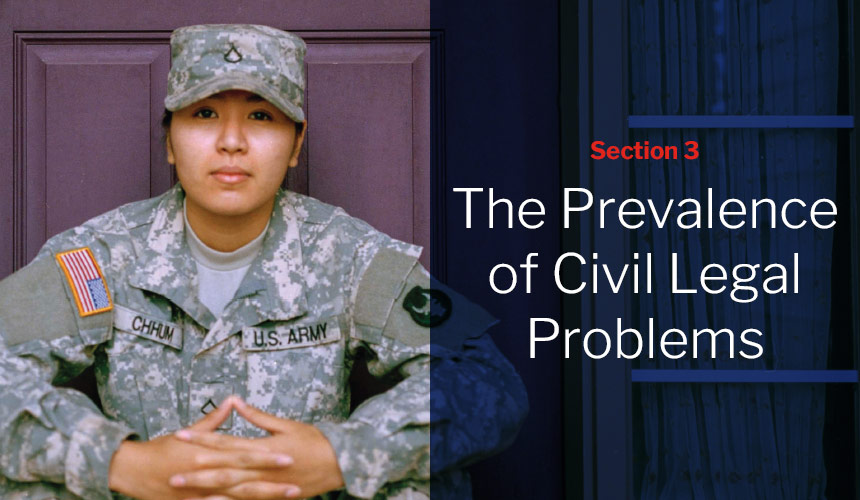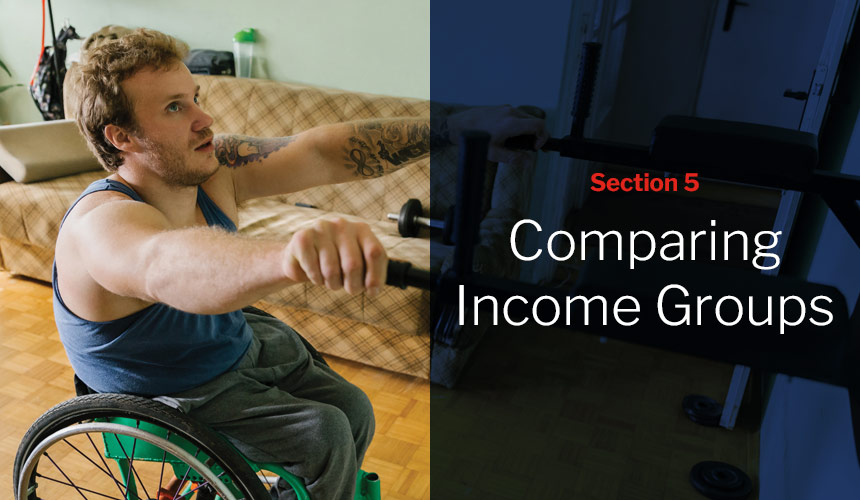Seeking Legal Help
Low-income Americans rarely seek legal help for their civil legal problems.
Low-income Americans sought legal help for 19% of their collective civil legal problems in the past year. As Figure 4A shows, they were slightly more likely to seek legal help for problems that impacted them substantially (25% of problems impacting them “very much” or “severely”) compared to less impactful problems (14% of problems affecting them “slightly” or “moderately”).
Figure 4A. Percent of problems for which low-income Americans sought legal help in the past year34
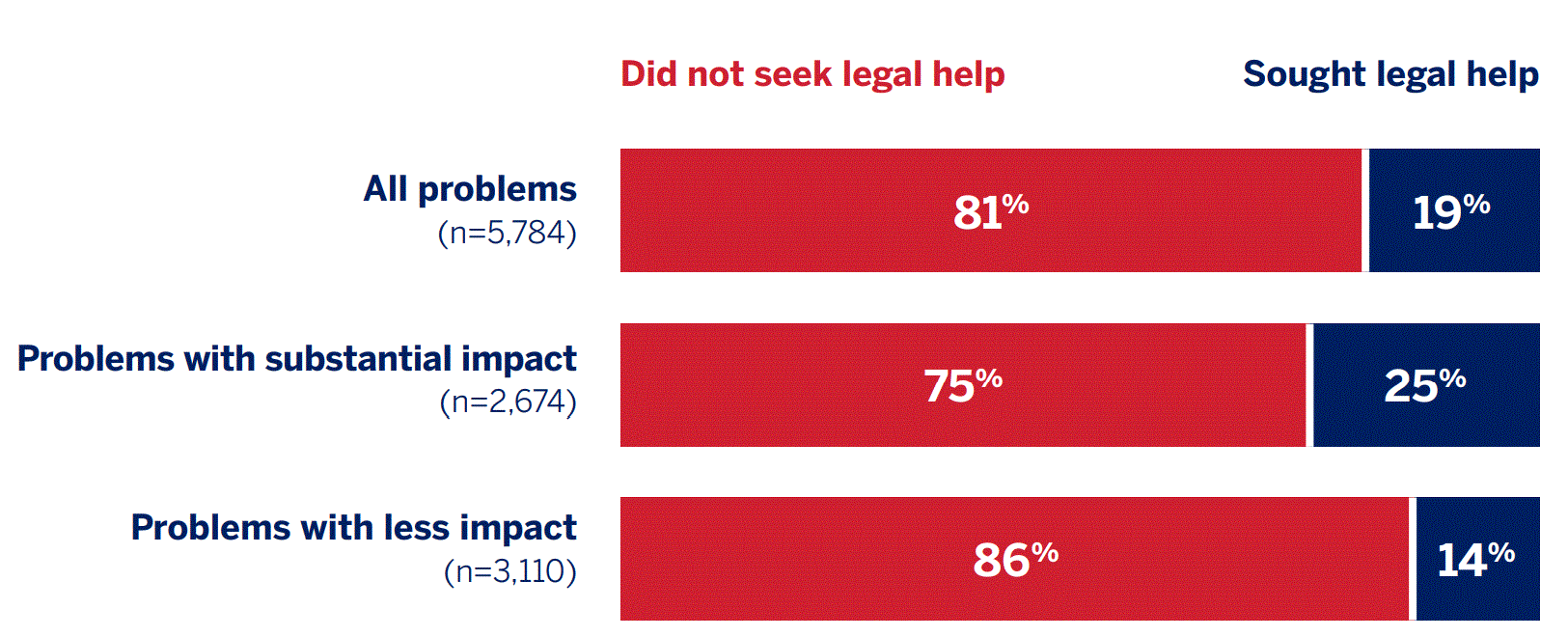
Percent of problems
Low-income Americans sought legal help for 25% of the civil legal problems that substantially impacted them in the past year.
People are more likely to seek legal help for problems that are more obviously “legal” like those involving legal documents and court proceedings.
Figure 4B presents the percent of civil legal problems for which low-income Americans sought legal help in the past year by problem type. As the figure shows, people were most likely to seek legal help for problems relating to family and safety (33%) and to wills and estates (41%).35 Compared to the other problems explored in the survey, these types of problems might be considered more obviously “legal” in nature. For example, many family and safety problems involve the courts, such as those related to child custody, divorce, and protection from violence. Similarly, the problems in the wills and estates category involve official legal documents and often involve court proceedings as well.
Figure 4B. Percent of problems for which low-income Americans sought legal help, by problem type36
![]()
41%
Wills & Estates
(n = 64)*
![]()
33%
Family & safety
(n = 690)
![]()
29%
Disability
(n = 171)*
![]()
22%
Housing
(n = 1,107)
![]()
20%
Employment
(n = 466)
![]()
19%
All problems
(n = 5,784)
![]()
18%
Official records
(n = 165)*
![]()
14%
Consumer issues
(n = 1,472)
![]()
14%
Income maintenance
(n = 626)
![]()
13%
Health care
(n = 675)
![]()
13%
Education
(n = 348)
Percent of problems experienced in each category.
*Small base sizes
The types of legal help that low-income Americans seek from lawyers reflect the wide variety of ways legal professionals can help people with these types of problems.
Figure 4C presents the various types of help low-income Americans wanted when they talked to a lawyer about their civil legal problems in the past year. The most common type of legal help sought was legal advice about specific situations (59% of the times they sought legal help). Other common types of help sought include representation in court (39%) and help filling out legal forms and documents (35%).
Figure 4C. Percent of problems for which low-income Americans sought various types of legal help from lawyers37
Percent of problems about which individuals talked to a lawyer | n = 822
Even when they seek legal help, low-income Americans often do not get all of the help they need.
Looking at all of the problems for which low-income Americans sought legal help, they say that they did not receive all of the help needed for nearly two-thirds (64%).38 If we narrow our focus to only those problems that affected them substantially, we find a similar result: low-income Americans did not receive all of the help they needed for 66% of these substantial problems.39
Survey-based Measure of the Justice Gap
The survey results allow us to estimate a survey-based measure of the justice gap among low-income Americans.40 To do so, we first identify the full set of problems low-income Americans experienced in the past year and then identify the set of these problems for which they did not receive any legal help or did not receive enough legal help.
Justice Gap =
(problems not receiving any legal help) +
(problems not receiving enough legal help)
all problems experienced
We define each part of this measure below:
- All problems experienced: All personally experienced problems that impacted respondents to some extent in the past year.41
- Problems not receiving any legal help: The subset of problems for which they did not seek any legal help.42
- Problems not receiving enough legal help: The subset of problems for which they sought legal help but did not receive as much as they needed.43
Low-income Americans either do not receive any legal help or do not receive enough legal help for the vast majority of their civil legal problems.
Figure 4D presents the survey-based justice gap measure for low-income Americans among three sets of problems: all of the civil legal problems they experienced, problems with substantial impact, and problems with less impact. As the figure shows, low-income Americans did not receive any or enough legal help for 93% of all of their problems. Interestingly, this estimate is essentially the same whether we look at problems with substantial impact (92%) or problems with less impact (94%).
Figure 4D. Percent of problems for which low-income Americans did not receive any or enough legal help in the past year (i.e., survey-based justice gap measure)44
Percent of problems experienced
Low-income Americans did not receive any legal help or enough legal help for 92% of the problems that substantially impacted them in the past year.
Barriers to Seeking and Receiving Legal Help
The survey data allow us to explore three types of potential barriers to seeking and receiving legal help:
- Knowledge barriers: We look at the extent to which people know that legal professionals can help resolve the types of civil legal problems explored in this survey.
- Attitudinal barriers: We explore people’s beliefs about the civil legal system and how it relates to people like them.
- Cost barriers: We consider the extent to which the (real or perceived) cost of receiving legal help might pose a barrier to getting it.
There is a low level of awareness around the fact that lawyers can help resolve many of the everyday civil legal problems people face.
For each civil legal problem that they personally experienced, respondents indicated whether they thought it was a type of problem that a lawyer or other legal professional could help resolve. The results point to a low level of awareness about how legal professionals can help. As Figure 4E shows, low-income Americans did not know if a lawyer could help resolve 74% of their problems. Indeed, they did not think a lawyer could help with 44% of their problems and were not sure for another 30%. Among low-income Americans with at least one reported problem, only 5% knew that a legal professional could help resolve all of the types of problems they experienced; the vast majority (95%) either did not think a legal professional could help or were not sure for at least one problem.
Figure 4E. Low-income Americans’ beliefs about whether a lawyer could help resolve their civil legal problems45

Percent of problems experienced | n=9,306
Most low-income Americans hold uncertain or negative perceptions of the civil legal system and how it relates to them.
The survey asked respondents to indicate the extent to which they agreed or disagreed with the following three statements about the U.S. civil legal system:46
- The civil legal system can help people like me solve important problems like those discussed in this survey.
- People like me are treated fairly in the civil legal system.
- People like me are able to use the civil legal system to protect and enforce their rights.
Figure 4F presents the percent of low-income Americans who agree, disagree, or are indifferent/unsure when it comes to these statements. As the figure shows, a minority (ranging from 28% to 40%) agrees with the statements, but most people either disagree or are indifferent/unsure. For example, only 28% of low-income Americans agree with the statement, “People like me are treated fairly in the civil legal system.” Forty-six percent are either indifferent or unsure, and another 24% disagree.
Only 28% of low-income Americans believe that people like them are treated fairly in the U.S. civil legal system.
Figure 4F. Low-income Americans’ attitudes about the U.S. civil legal system47

Percent of individuals | n=2,003
More than one-half of low-income Americans doubt they could find and afford a lawyer if they needed one.
The survey asked respondents how confident they are that they would be able find a lawyer or other legal professional that they could afford if they needed help on a serious civil legal problem, such as preventing an eviction, foreclosure, or the loss of custody of a child. Figure 4G presents the corresponding results. As the figure shows, less than one-half (45%) of low-income Americans express confidence that they could find a lawyer that they could afford while 53% either have low confidence or are not sure.
53% of low-income Americans do not know if they would be able to find a lawyer that they could afford if they needed help with a serious civil legal problem.
Figure 4G. Low-income Americans’ confidence in their ability to find a lawyer that they could afford48

Percent of individuals | n=2,003
Many low-income Americans cite cost as a reason for not seeking legal help in the past year.
Among those who did not seek legal help for at least one of their recent civil legal problems, nearly one-half (46%)49 cited concerns about cost as a reason why. There is also evidence to suggest that concerns about cost stood in the way of others’ ability to get all of the help they needed. Indeed, among those who sought legal help but did not get all that they needed for one or more problems, 61% say one of the reasons was that it was too expensive to get more help.50
Impact of the COVID-19 Pandemic
Low-income Americans did not receive any or enough legal help for 91% of the pandemic-related civil legal problems that substantially impacted their lives.
Low-income Americans sought legal help for 22% of the substantial problems that they attribute to the COVID-19 pandemic in the past year.51 Consistent with broader findings, two common reasons cited for not seeking legal help for these problems were concerns about cost and the belief that lawyers could not help with these problems.52
All in all, low-income Americans did not receive any legal help or enough legal help for 91% of the pandemic-related problems that impacted them substantially. Figure 4H below presents estimates for the survey-based justice gap measure for the three types of problems most frequently attributed to the pandemic (i.e., income maintenance, education, and housing).
Figure 4H. Percent of substantial, pandemic-related problems for which low-income Americans did not receive any or enough legal help in the past year (i.e., survey-based justice gap measure)53
Percent of pandemic-related problems experienced with substantial impact
*Small base size
Sought legal help for 25% of substantial problems.
Did not receive any or enough legal help for 93% of substantial problems.
Sought legal help for 29% of substantial problems.
Did not receive any or enough legal help for 88% of substantial problems.
Sought legal help for 29% of substantial problems.
Did not receive any or enough legal help for 92% of substantial problems.
Sought legal help for 21% of substantial problems.
Did not receive any or enough legal help for 92% of substantial problems.
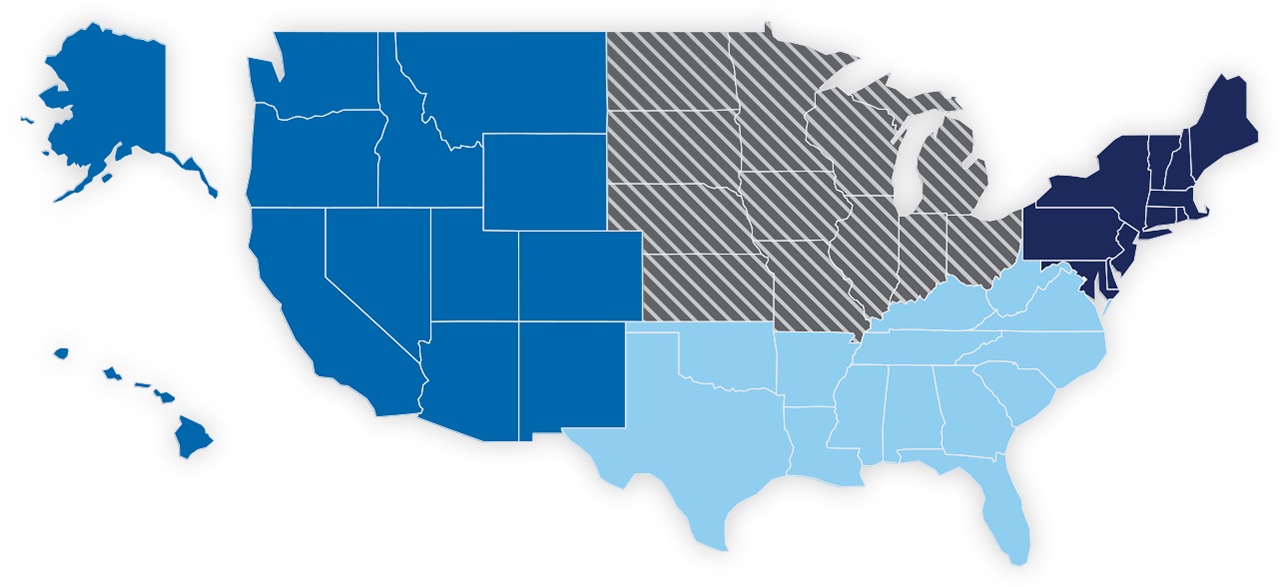
Sought legal help for 26% of substantial problems.
Did not receive any or enough legal help for 91% of substantial problems.
Sought legal help for 21% of substantial problems.
Did not receive any or enough legal help for 94% of substantial problems.
Sought legal help for 34% of substantial problems.
Did not receive any or enough legal help for 84% of substantial problems.
Sought legal help for 21% of substantial problems.
Did not receive any or enough legal help for 95% of substantial problems.
Sought legal help for 24% of substantial problems.
Did not receive any or enough legal help for 90% of substantial problems.
Sought legal help for 29% of substantial problems.
Did not receive any or enough legal help for 88% of substantial problems.

